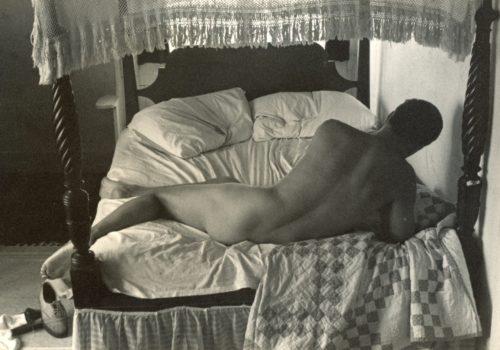Keith de Lellis Gallery presents the exhibition PaJaMa. Beginning in 1937 and for the next decade and beyond, the artists Paul Cadmus (1904-1999), Jared French (1905- 1988), and Margaret Hoening French (1906-1998) spent their summers by the sea, ending each day by going out— as Cadmus later recalled—“when the light was best” to make photographs of one another with a lightweight handheld Leica camera owned by Margaret. “They were just playthings. We would hand out these little photographs when we went to dinner parties, like playing cards.” These “playing cards” were small in scale—most commonly 6 ½” x 4 ½” or less often 6” x 9”, 7” x 9”, 3” x 4”, or 4” x 4”; their moniker “PaJaMa” — formed by the first syllable of the first names of the three collaborators — conjured wholesome pastimes and childhood games — “just playthings.” Such allusions to games and play, however, combine spontaneity and fun with rule-bound procedures; individual personalities with group identity; childlike antics with very adult negotiations, carried out in bedrooms.
Wintering in New York, the three principals, along with friends and associates, rented cottages in the summer, on Fire Island, in Provincetown, and on Nantucket. Joining the trio at various points in their photographic play throughout these years was the artist George Tooker, who entered the circle in 1946 when Paul and he became lovers; the writer Glenway Wescott and his life partner, Monroe Wheeler; Fidelma Kirstein (née Cadmus) and her husband, Lincoln Kirstein—friend, mentor, and patron of many in the group — along with a shifting field of friends and visitors. Of this group, George Platt Lynes — although not part of the PaJaMa collaboration — was already a well-known photographer; he brought a Rolleiflex, which he used to take photographs on Fire Island weekends. His social and artistic world would interweave with theirs, mutually shaped by the practice of staging photographs of themselves and one another, a practice that spilled over into Lynes’s work as a professional studio photographer.
Never intended for exhibition or sale, the photographs made by PaJaMa circulated privately among this network. As Cadmus recalled, “Of course, we never thought of this work as being sellable. Those photos were meant to be tokens of friendship … They were essentially family photographs.” But they were family photographs of a particularly revealing nature, falling well outside accepted definitions of that institution in the years around and following World War II. The three PaJaMa principals were part of a queer network that experimented with new forms of private life enacted in daily exchanges, and issuing in new collaborative practices. Their shifting romantic and emotional alignments resisted the ostensibly stable pairings expected of heterosexual couplings. Jared French was sexually drawn to both men and women; others in the group were also not bound by the socially enforced containment of sexual desire to the nuclear family. These experiments all took shape in a decade most often understood through the figure of the autonomous cisgender male creator, most fully realized in the white Abstract Expressionist painter of the New York School that took shape in the following decade. Turning away from the pursuit of heroic individuality, PaJaMa created a vivid new language of intimate social performance centered around their ménage à trois, and acted out within a sympathetically responsive natural world.
Above text from Body Language: The Queer Staged Photographs of George Platt Lynes and PaJaMa, by Nick Mauss and Angela Miller, Edited by Anthony W. Lee. Published by University of California Press. Excerpt from ‘Pajama Drama’ by Angela Miller, pp 75-76
© 2023 by Nicholas Mauss, Angela Miller, and Anthony W. Lee
PaJaMa : Paul Cadmus, Jared French & Margaret French
May 30th to August 1st, 2024
Keith de Lellis Gallery
41 E 57th St #703
New York, NY 10022
www.keithdelellisgallery.com
















